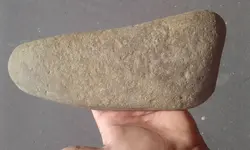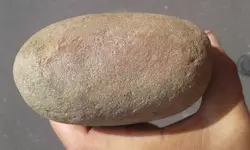I agree that this stone shows no obvious signs of being pecked, ground, or humanly worked to manipulate it into the shape or form it currently has.
With that said, I do believe this stone shows some light pecking, grinding or wear on the high spots and ends. This type of wear looks like it could be present due to this stone having been used carefully as a crushing or pressing tool by humans, or it could just be there because this stone tumbled naturally in a creek for a long time, or spent some time being roughly transported with other stones, such as might occur if it was gathered from a field tossed into a wheelbarrow with similar stones, then dumped into a fence row or other area where people tend to gather and store stones.
If you look carefully you can see how the depressed area has a near solid grey patina, and that grey patina has been worn away to an extent on the ends and high spots.
If this item were found on a known prehistoric site where stones of this type were not deposited by geologic forces, I would consider it an artifact, but I still probably would not bring it home, mainly due to it's size, weight, and the dubious and debatable attribution of it being an artifact. If this item were found along a stream bank, or any other place where stones of this type were naturally found, you shouldn't think twice about leaving it right there.



